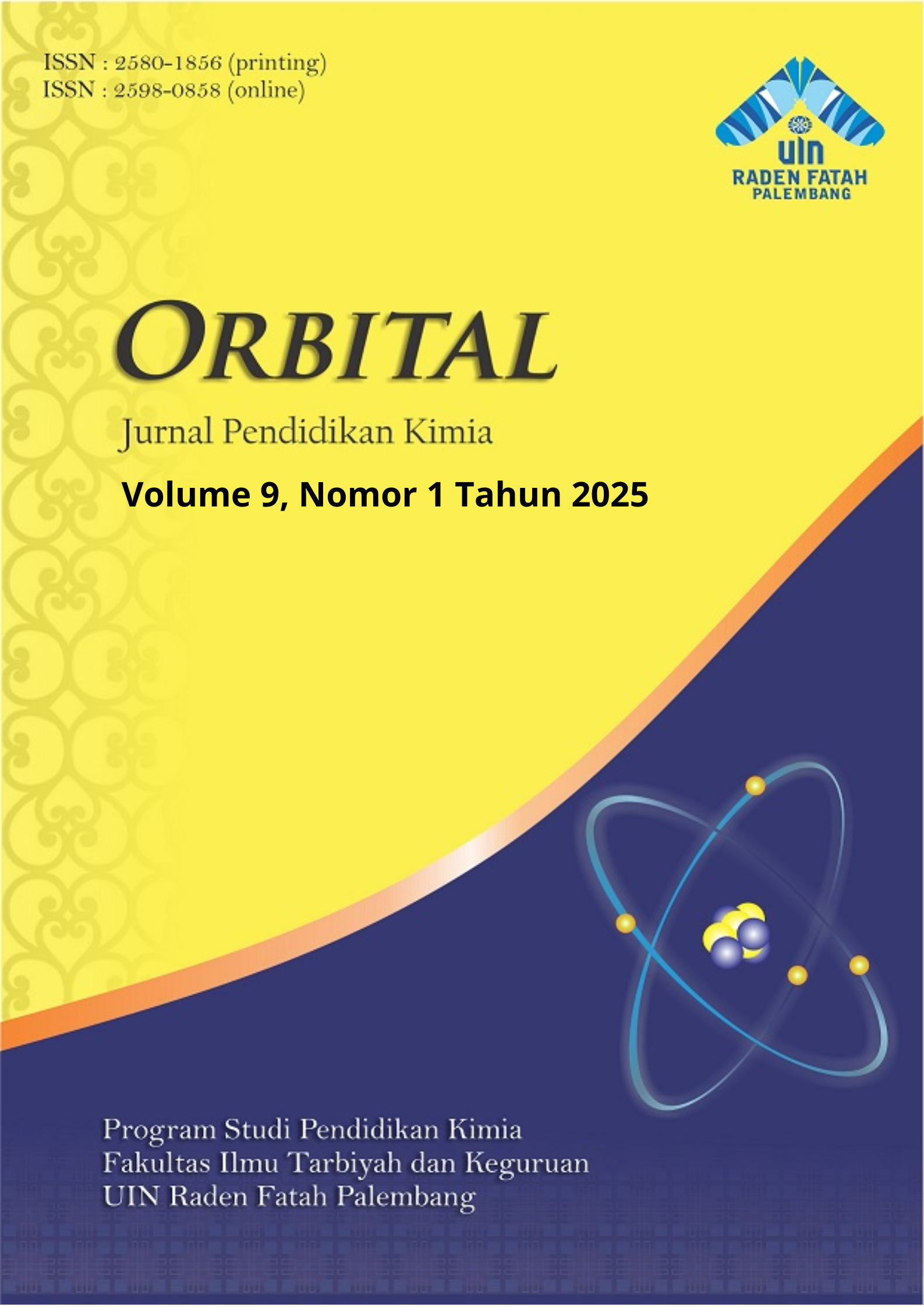Mapping the Mastery Level of Basic Thermodynamics Concepts among Chemistry Education Students
Main Article Content
Abstract
Thermodynamics is a fundamental yet conceptually challenging topic that chemistry education students must master, particularly as future science teachers. This study aimed to map students’ conceptual mastery across six core thermodynamic topics; gas systems and laws, kinetic theory of gases, state and state functions, systems and surroundings, thermodynamic processes, and the first law of thermodynamics, while identifying the most difficult areas and the misconceptions that arise. The study involved 125 students from the Chemistry Education Study Program who had completed the thermodynamics course. A 45-item multiple choice test was administered, and data were analyzed using descriptive statistics. Concept mastery was categorized into five levels (very high, high, medium, low, very low), and distractor analysis was used to uncover patterns of misconceptions.The results showed very high mastery in thermodynamic processes (93,92%), high mastery in gas systems and laws, kinetic theory of gases, state and state functions, and systems and surroundings (ranging from 79,80% to 84,80%), and moderate mastery in the first law of thermodynamics (72,93%). Common errors included confusion about sign conventions, energy flow, entropy, and the difference between state and process functions. The findings emphasize the importance of shifting from procedural to conceptual teaching strategies. Visual models, simulations, and diagnostic tools are recommended to address persistent misconceptions. This study contributes to improving thermodynamics instruction in chemistry teacher education and serves as a reference for further research on conceptual change in science learning.
Article Details

This work is licensed under a Creative Commons Attribution-ShareAlike 4.0 International License.
How to Cite
References
Baran, M., & Sozbilir, M. (2018). An Application of Context- and Problem-Based Learning (C-PBL) into Teaching Thermodynamics. Research in Science Education, 48(4), 663–689. https://doi.org/10.1007/s11165-016-9583-1
Bray, A., & Tangney, B. (2015). Enhancing student engagement through the affordances of mobile technology: a 21st century learning perspective on Realistic Mathematics Education. Mathematics Education Research Journal, 28(1).
Brown, B., & Singh, C. (2021). Student understanding of the first law and second law of thermodynamics. European Journal of Physics, 42(6). https://doi.org/10.1088/1361-6404/ac18b4
Brown, B., & Singh, C. (2022). Student understanding of thermodynamic processes, variables and systems. European Journal of Physics, 43(5). https://doi.org/10.1088/1361-6404/ac7af2
Brundage, M. J., Meltzer, D. E., & Singh, C. (2024). Investigating introductory and advanced students’ difficulties with entropy and the second law of thermodynamics using a validated instrument. Physical Review Physics Education Research, 20(2), 20110. https://doi.org/10.1103/PhysRevPhysEducRes.20.020110
diSessa, A. A. (2018). A Friendly Introduction to “Knowledge in Pieces”: Modeling Types of Knowledge and Their Roles in Learning. July, 65–84. https://doi.org/10.1007/978-3-319-72170-5_5
Foroushani, S. (2019). Misconceptions in engineering thermodynamics: A review. International Journal of Mechanical Engineering Education, 47(3), 195–209. https://doi.org/10.1177/0306419018754396
Gao, Y., & Chaudhari, P. (2021). A free-energy principle for representation learning. Machine Learning: Science and Technology, 2(4). https://doi.org/10.1088/2632-2153/abf984
Gaskell, D. R., & David E, L. (2024). No Title. CRC Press.
Georgiou, H., & Sharma, M. D. (2015). Does using active learning in thermodynamics lectures improve students’ conceptual understanding and learning experiences? European Journal of Physics, 36(1). https://doi.org/10.1088/0143-0807/36/1/015020
Haglund, J., Andersson, S., & Elmgren, M. (2015). Chemical engineering students’ ideas of entropy. Chemistry Education Research and Practice, 16(3), 537–551. https://doi.org/10.1039/c5rp00047e
Holme, T. A., Luxford, C. J., & Brandriet, A. (2015). Defining Conceptual Understanding in General Chemistry. Journal of Chemical Education, 92(9), 1477–1483. https://doi.org/10.1021/acs.jchemed.5b00218
Loverude, M. E., Kautz, C. H., & Heron, P. R. L. (2002). Student understanding of the first law of thermodynamics: Relating work to the adiabatic compression of an ideal gas. American Journal of Physics, 70(2), 137–148. https://doi.org/10.1119/1.1417532
Madden, S. P., Jones, L. L., & Rahm, J. (2011). The role of multiple representations in the understanding of ideal gas problems. Chemistry Education Research and Practice, 3.
Maksum, M. J., Sihaloho, M., & Kilo, A. La. (2017). Analisis Kemampuan Pemahaman Siswa pada Konsep Larutan Penyangga Menggunakan Three Tier Multiple Choice Tes. Jambura Journal of Educational Chemistry, 12(1), 47–53.
Martinez, B. L., Sweeder, R. D., VandenPlas, J. R., & Herrington, D. G. (2021). Improving conceptual understanding of gas behavior through the use of screencasts and simulations. International Journal of STEM Education, 8(1). https://doi.org/10.1186/s40594-020-00261-0
Mayer, R. E. (2009). Multimedia Learning (2nd ed.). Cambridge University Press.
Meissner, B., & Bogner, F. (2013). Towards Cognitive Load Theory as Guideline for Instructional Design in Science Education. World Journal of Education, 3(2), 24–37. https://doi.org/10.5430/wje.v3n2p24
Natalis, V., & Leyh, B. (2025). Improving the teaching of entropy and the second law of thermodynamics: a systematic review with meta-analysi. Chemistry Education Research and Practice, 1, 9–33.
Nurulwati, Halim, A., Mailizar, Syukri, M., & Saputri, M. (2024). Identification of Students’ Misconceptions to the Kinetic Gas Theory in Physics. Jurnal Penelitian Pendidikan IPA, 10(6), 3113–3117. https://doi.org/10.29303/jppipa.v10i6.8018
Sudarmo, N. A., Lesmono, A. D., & Harijanto, A. (2018). Analisis Kemampuan Berargumentasi Ilmiah Siswa Pada Konsep Termodinamika. Jurnal Pendidikan Fisika, 7(1), 196–201.
Taber, K. S. (2021). Encyclopedia of Science Education. Encyclopedia of Science Education, April, 0–5. https://doi.org/10.1007/978-94-007-6165-0
Treagust, D., Nieswandt, M., & Duit, R. (2018). Sources of students difficulties in learning Chemistry. Educación Química, 11(2), 228. https://doi.org/10.22201/fq.18708404e.2000.2.66458
Usu, N., Rahmanpiu, & Murhadi, M. A. (2019). Analisis Miskonsepsi Siswa Pada Materi Kesetimbangan Kimia Menggunakan Tes Diagnostik Two Tier Multiple Choice. Jurnal Pendidikan Kimia FKIP, 4(3), 226–237.
Yildiz, A. (2023). Opinions of Physics Teachers on the Teaching of Physical Constants. December. https://doi.org/10.26579/jocures.13.2.2
Zhu, L., & Xiang, G. (2022). Investigating student understanding of a heat engine: A case study of a Stirling engine. Physics Education, 57(1), 1–7. https://doi.org/10.1088/1361-6552/ac342b

